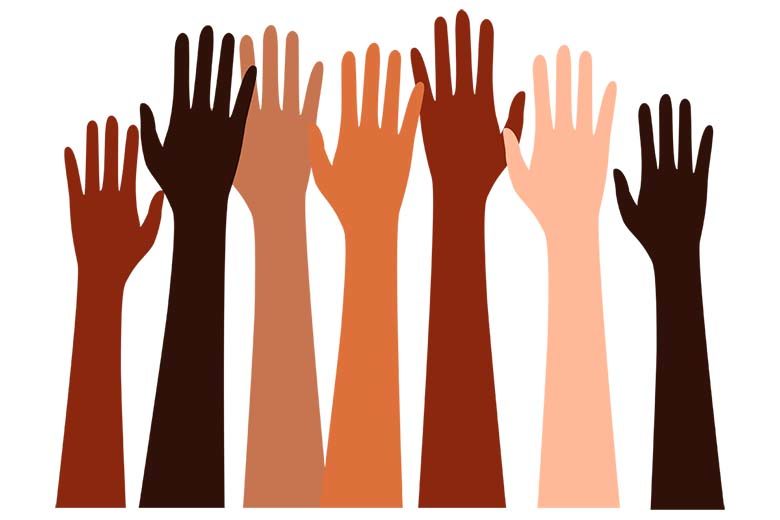
Many changes, big and small, are needed to end longstanding racism that exists in health care, including nutrition and dietetics. High-level changes include cultivating a more diverse practitioner population, while individual efforts include personal self-reflection, practicing cultural humility and actively advocating for and creating change.
The Importance of Diversity
As of June 2020 there were 93,320 registered dietitian nutritionists in the United States: 81.1 percent report being white, 3.9 percent Asian, 3.1 percent Hispanic or Latino, 2.6 percent Black or African American, 1.3 percent Native Hawaiian Pacific Islander and 0.3 percent American Indian or Alaskan Native. Compare that to July 2019 statistics from the U.S. Census Bureau: 60.4 percent of the population is white, 5.9 percent Asian, 18.3 percent Hispanic or Latino, 13.4 percent Black or African American, 0.2 percent Native Hawaiian Pacific Islander and 1.3 percent American Indian or Alaskan Native.
When the demographics of practitioners do not reflect those of the populations they serve, research suggests there is a higher risk for suboptimal care through compromised access, lower quality treatment and a reduced ability to build rapport. The demographics of nutrition and dietetics practitioners often do not accurately reflect the demographics of the populations they serve.
While large-scale efforts are needed to make systemic changes, RDNs and nutrition and dietetics technicians, registered, must additionally acknowledge their potential role in causing harm by addressing, recognizing and combatting biases (conscious and subconscious) and preventing microaggressions. Biases and microaggressions can impact communication, the amount of time spent with patients or clients, the ability to express empathy toward certain patients or clients and the type of treatment prescribed.
Understanding Microaggressions
Microaggressions can be defined as everyday slights, indignities, put-downs or insults directed toward an individual because of their group identity; for example, people of color, women or LGBTQ+ populations. Microaggressions are essentially an expression of biases and may be performed subconsciously or consciously, but contain a hidden insult or message directed at the target group.
Examples of racial microaggressions include a white woman clutching her purse as a Black man approaches because she believes he may be a criminal; asking a Latino person where they are from, assuming they are not American; or someone asking an Asian person for help with math, assuming all Asians are proficient at mathematics.
Microaggressions can be sorted into three categories: microassaults, microinsults and microinvalidations. Microassaults are often deliberate actions or statements meant to hurt a person, such as a white person refusing to speak to a person of color or calling that person by a derogatory name. Microinsults are subtle snubs that could take the form of sarcasm, such as assuming a person’s intelligence based on race or where they live. Microinvalidations exclude, negate or invalidate a person’s thoughts, feelings or life experience. An example may be a white person saying they “don’t see color.”
Addressing Personal Biases
To start confronting personal bias and racism, practitioners should first adopt a growth mindset and practice cultural humility, which supports learning. Rather than viewing cultural competence as an end goal, cultural humility and a growth mindset reflect the idea that learning is never complete.
As the United States becomes more diverse, practitioners should continually seek to learn more about the populations they serve. Practicing cultural humility and adopting a growth mindset could be as simple as asking a patient or client what types of foods they eat, rather than assuming based on the individual’s race or ethnicity; or it can be as in-depth as intense research and education through reading, conversation, podcasts, webinars, classes and other avenues. The main point is that this process should never end.
Start addressing and preventing microaggressions by developing appropriate language, considering the impact of what you do and do not say. For example, do you address a man with a PhD as “doctor” but address a woman with a PhD by her first name? What if the individual with a PhD is a Black person versus a white person — does that change how you address them? Does your language differ based on the race of a patient or client or the size and weight of an individual? In addition to self-reflection, itmay be beneficial to survey clients and patients to ask if your language has ever been perceived as microaggressive.
Encourage open and honest dialogue with yourself and trusted colleagues; urge them to share without ridicule. This dialogue should set in motion processes needed to create a more inclusive and equitable environment within your own practice and workplace. Write down actionable steps and goals; define what an equitable, diverse and inclusive workplace means to you and your team and revisit the conversation frequently. Eradicating discrimination, including microaggressions, cannot occur without individuals acknowledging their own role and working toward a more diverse, inclusive and equitable health care system.
To learn how to react as a target of microaggressions in the workplace and how to serve as an ally to victims of microaggressions, listen to the FNCE® 2019 session “Combatting Unconscious Bias and Preventing Microaggressions: A Professional Duty.” This recorded session also includes information about the Academy’s work to create a more diverse profession, how practitioners can face their own biases and helpful resources.
References
Combatting Unconscious Bias and Preventing Microaggressions: A Professional Duty. FNCE® 2019. Academy of Nutrition and Dietetics.
Examples of Racial Microaggressions. University of Minnesota School of Public Health website. Accessed June 10, 2020.
Quick Facts United States. United States Census Bureau website. Accessed June 9, 2020.
Registered Dietitian (RD) and Registered Dietitian Nutritionist (RDN) by Demographics. Commission on Dietetic Registration website. Accessed June 10, 2020.
